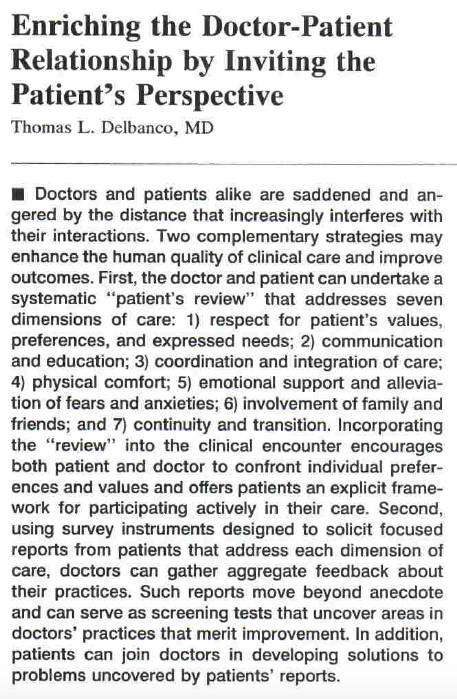
March 1, 1992.
25 years ago.
Yesterday I asked When was “Enriching the relationship by inviting the patient perspective” published? The words in that paper’s abstract [right] could have been written today – literally every word. It was printworthy a quarter century ago Wednesday, and it still is today.
Why? It’s appeared here repeatedly: despite the scientific nature of medicine, facts don’t change practice. Something else is needed. And that’s a problem.
You see, participatory medicine is, above all else, a cultural movement, even more than a medical movement. We’re here as an activist organization, committed not just to talking about change but to creating it. So when facts are presented so healthcare could improve, and it doesn’t – the world doesn’t budge – it may be fine to consultants (they can sell reports about the lack of change), but to us it’s not.
Trillions of dollars spent, and it hasn’t changed. And it’s not just the abstract that’s still true today – here are more excerpts:
Doctors and patients find themselves drifting apart. As smaller and smaller players in ever growing systems, both we who offer care and those who seek it often keep a distance from one another.
Twenty-five years ago!
We doctors are told how arrogant we appear, even as we wonder what is happening to the human side of care that attracted so many of us.
Twenty-five years ago! The paper continues:
In 1988, my colleagues and I set out to learn more about what matters to patients, above and beyond the primarily biomedical aspects of their clinical management. …
What did we learn? Patients do not focus on prettier waiting rooms, better hospital food, or problems with parking.
That one bowled me over because every year at one conference or another I hear a hospital person say that to them, patient-centered care just boils down to patients whining about cosmetic things. Reality, though – even 25 years ago:
Rather, they are concerned about issues of clinical significance that have nothing to do with what we think of as the doctor’s ” image or the hospital‘s “atmosphere.”
They want to be able to trust the competence and efficiency of their caregivers.
They want to be able to negotiate the health care system effectively and to be treated with dignity and respect.
Patients want to understand how their sickness or treatment will affect their lives, and they often fear that their doctors are not telling them everything they know.
Patients worry about and want to learn how to care for themselves away from the clinical setting. They want us to
focus on their pain, physical discomfort, and functional disabilities.
They want to discuss the effect their illness will have on their family, friends, and finances.
And they worry about the future.
Dr. Delbanco goes on to describe a 1991 paper he co-authored in the policy journal Health Affairs, “Patients Evaluate their Hospital Care: A National Survey” (free PDF), which led to the thoughts in this paper. From the Health Affairs paper:
It is now widely accepted that it is desirable to monitor and assess the structure, process, and outcomes of medical care when evaluating quality. In the past, process of care has been evaluated almost exclusively on the basis of information available in medical records; patients’ observations are not usually included in quality assurance activities. Studies that elicit reports from patients increasingly are viewed as an important method of assessing hospital care.
A few items from that paper:
- 45% of patients said they’d not been told about daily routines
- 23% said they didn’t know which doctor was in charge
- 17% said not knowing what it would cost was worrisome
- 20% said staff wouldn’t go out of their way to help
I don’t know if that exact same study has been replicated recently – anyone got a link? It would be great to compare.
And it all sounds like it would be a value application today for a grant to study healthcare improvement. And that begs the question:
What will it take
to create actual change
from all this research?
And what the heck did all those researchers do
with all the grant money
that’s been spent on studying this
for 30 years?
Was it all spent on characterizing the problem
(like understanding how fires start in houses)
and none spent on preventing and extinguishing them?
Or has research about the fixes
been ignored by people who have
other priorities?
The whole 1992 paper, 25 years ago this week, is here (PDF). Please read it!
And please, let’s talk about why these words are still fresh today. Why has it not changed? Why do these cultural problems persist, making the care experience so often sub-optimal, even as medicine itself gets better and better at saving lives like mine?
The closing words of that paper sound like part of the vision that led 13 of us to create this Society in 2009:
Combining a systematic consideration of patients’ individual characteristics in clinical practice with the routine solicitation of their aggregate perceptions will engender a powerful synergism.
It will help doctors draw closer to their patienTs and restore and strengthen public trust.
It will both improve the quality of our care and add to the joy of being a doctor.
Here’s to that. Now let’s get to work: what will it take to make that real?






Oh good grief…thought patient centred care was new & that’s why there is so much resistance from some healthcare professionals and organisations towards the concept